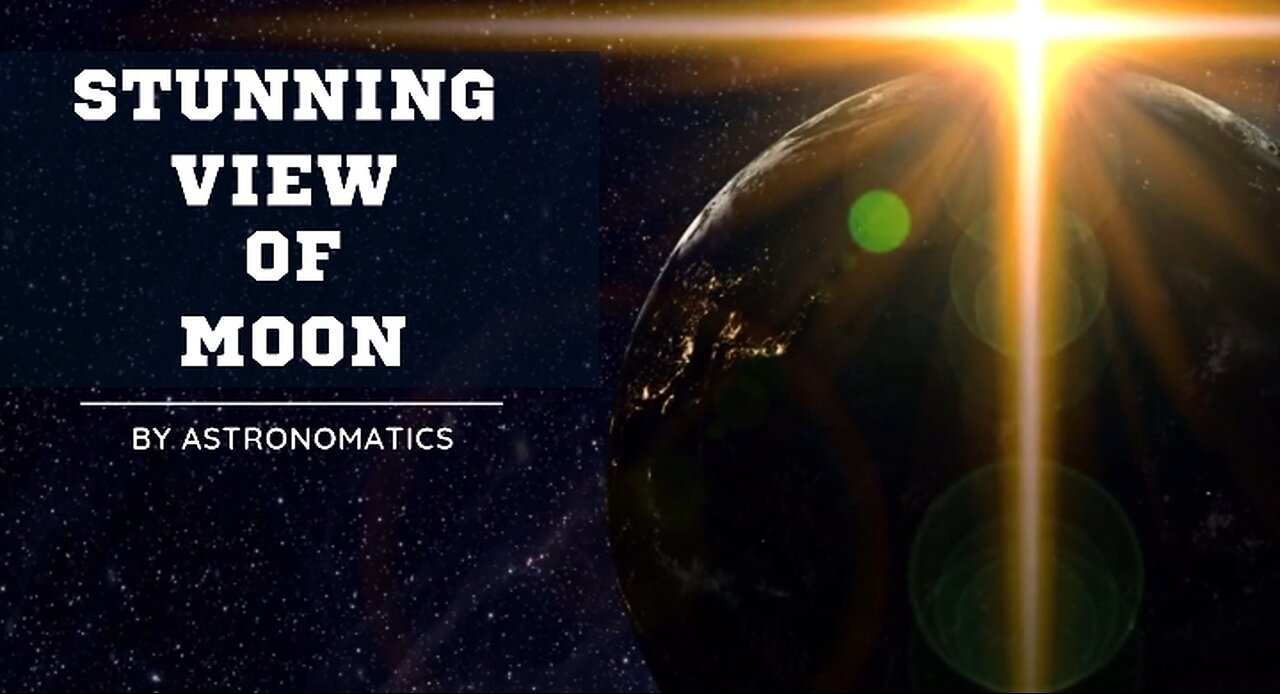Premium Only Content

Stunning view of Moon
The Moon is Earth's only natural satellite. It orbits at an average distance of 384400 km (238900 mi), about 30 times the planet's diameter. The Moon always presents the same side to Earth, because gravitational pull has locked its rotation to the planet. This results in the lunar day of 29.5 days matching the lunar month. The Moon's gravitational pull – and to a lesser extent the Sun's – are the main drivers of the tides.
The Moon is in geophysical terms a planetary-mass object or satellite planet. It has a mass that amounts to 1.2% of Earth's, and a diameter that is roughly one-quarter of Earth's or with 3,474 km (2,159 mi) about as wide as Australia.[17] Within the Solar System it is the most massive and largest satellite in relation to its parent planet, the fifth most massive and largest moon overall, and more massive and larger than all known dwarf planets.[18] Its surface gravity is about one sixth of Earth's, about half of that of Mars, and after Jupiter's moon Io the second highest among all Solar System moons. The body of the Moon is differentiated and terrestrial, with no significant hydrosphere, atmosphere, or magnetic field. It formed 4.51 billion years ago, not long after Earth's formation, out of the debris from a giant impact between Earth and a hypothesized Mars-sized body called Theia.
The lunar surface is covered in lunar dust and marked by mountains, impact craters, their ejecta, ray-like streaks and, mostly on the near side of the Moon, by dark maria ("seas"), which are plains of cooled magma. These maria formed when large impacts on the far side of the Moon heated up low lying layers of its crust on the near side. The Moon is, beside when passing through Earth's shadow during a lunar eclipse, always illuminated by the Sun, but from Earth the visible illumination shifts during its orbit, producing the lunar phases.[19] The Moon is the brightest celestial object in Earth's night sky. This is mainly due to its large angular diameter, while the reflectance of the lunar surface is comparable to that of asphalt. The apparent size is nearly the same as that of the Sun, allowing it to cover the Sun almost completely during a total solar eclipse. From Earth about 59% of the lunar surface is visible over time due to cyclical shifts in perspective (libration), making parts of the far side of the Moon visible.
For humans the Moon has been an important source of inspiration and knowledge, having been crucial to cosmography, mythology, religion, art, time keeping, natural science, and spaceflight. On September 13, 1959, the first human-made object to reach an extraterrestrial body arrived on the Moon, the Soviet Union's Luna 2 impactor. In 1966 the Moon became the first extraterrestrial body where soft landings and orbital insertions were achieved. On July 20, 1969, humans for the first time landed on the Moon and any extraterrestrial body, at Mare Tranquillitatis with the lander Eagle of the United States' Apollo 11 mission. Five more crews were sent between then and 1972, each with two men landing on the surface. The longest stay was 75 hours by the Apollo 17 crew. Thereafter exploration of the Moon has continued robotically, with crewed missions being planned to return starting in the late 2020s.
-
 1:13:58
1:13:58
Steven Crowder
3 hours agoThe Friday Show: Trad Wives, The Walz Family, & the N-Word
201K128 -
 DVR
DVR
BitLab Academy
38 minutes agoBitcoin Past $1 Million! Altcoin Ban! MSTR To Buy $84 Billion BTC!
2.22K -
 1:06:35
1:06:35
The Rubin Report
1 hour agoProtester Actually Thought She'd Outsmarted Tech CEO, Until He Asked This
25.2K17 -
 1:02:35
1:02:35
Geeks + Gamers
2 hours agoJeremy Renner Tells Marvel To F*ck Off, Thunderbolts In Theaters, GTA 6 DELAYED
53K5 -
 LIVE
LIVE
Flyover Conservatives
11 hours agoBill Belichick girlfriend, European Blackouts and 3 Tips to Grow Your Business | FOC Show
388 watching -

Dr. Eric Berg
4 days agoThe Dr. Berg Show LIVE - May 2, 2025
19.2K3 -
 LIVE
LIVE
The Shannon Joy Show
2 hours ago🔥🔥Friday Freestyle LIVE With Shannon Joy! Ask Me Anything On The Open Live Chat!🔥🔥
197 watching -
 LIVE
LIVE
Film Threat
16 hours agoTHUNDERBOLTS* SPOILERS + TONS OF REVIEWS! | Film Threat Livecast
70 watching -

Tudor Dixon
1 hour agoTrump's 100 Days: Michigan's Reaction | The Tudor Dixon Podcast
-
 1:01:06
1:01:06
VINCE
4 hours agoA Shocking Revelation About What's Coming Next | Episode 35 - 05/02/25
205K126